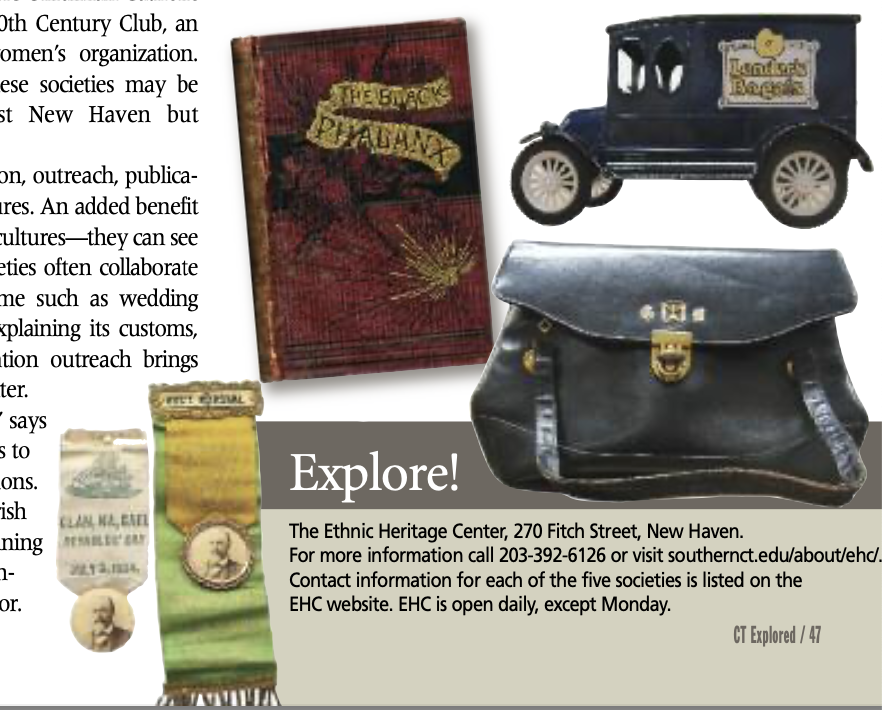By Mary M. Donohue
(c) Connecticut Explored Inc. Fall 2013
Subscribe/Buy the Issue!
“Celebrating diversity and recognizing our common humanity” – Mission of the Ethnic Heritage Center
Most historical societies are rooted in a specific place: a town, a city, or a state. But ethnic historical societies trace over time people from one or more countries who arrived here as settlers, immigrants, émigrés, expatriates, refugees, indentured servants, or enslaved persons. They tell the stories of peoples bound by culture, language, and country of origin. In New Haven, five ethnic historical societies have joined forces at the Ethnic Heritage Center (EHC) on the Southern Connecticut State University campus. The Connecticut Irish American Historical Society, Connecticut Ukrainian American Historical Society, Greater New Haven African American Historical Society, Italian American Historical Society, and the Jewish Historical Society of Greater New Haven all share exhibition space, research facilities, and collections storage.
The tangible remnants of the immigrant experience—family photos, foreign language newspapers, and scrapbooks—often are lost. Each society at ECH seeks to save rare and important documents that have survived. “No matter how small or large the collection, saving it is a step in the right direction,” states Valarie Bertrand, co-founder and president of the Greater New Haven African American Historical Society. Jewish Historical Society archivist Marv Bargar explains, “These are one-of-a kind items for businesses, organizations, lodges, and synagogues that no longer exist.” Each society has important strengths in its collections—a run of a local Italian language newspaper, more than 100,000 Irish American-related photographs, Jewish cemetery indexes, early photographs from St. Michael’s Ukrainian Catholic Church, or the records of the Women’s 20th Century Club, an early 20th-century African American women’s organization. Resources in the collection of any of these societies may be valuable to those researching not just New Haven but Connecticut history.
Each society vigorously pursues education, outreach, publications, Web sites, award programs, and lectures. An added benefit of the ECH “is that it brings in people of all cultures—they can see everything at once,” says Bargar. The societies often collaborate on exhibitions exploring a common theme such as wedding traditions or holidays, with each group explaining its customs, national costumes, and foodways. Education outreach brings high school and college students to the center. “You can see the excitement in their faces,” says Bertrand. Their visits are often the catalyst for students to recognize the struggles of previous generations. “High school students have also used the Irish American collection to research award-winning History Day projects,” says Neil Hogan, Irish American Historical Society newsletter editor. [See Hogan’s story “Connecticut’s Irish Servants” on page xx.]
The societies also serve family historians and genealogists. The societies’ archivists can, for example, help people find someone to translate family documents written in Russian, Italian, or Yiddish.
The EHC frequently collaborates with other historical societies around the state. For instance, the Jewish Historical Society of Greater New Haven lent photos and artifacts to the New Haven Museum for its exhibition “Beyond the New Township: Wooster Square” about the historic Wooster Square neighborhood (on view through February 28, 2014; see Afterword in this issue.) The Irish American Historical Society received a 2013 grant from the State Historic Preservation Office’s “Our Places, Our Stories” grant program to identify Irish heritage sites across the state and create an Irish Heritage Trail Web site.
Mary M. Donohue is a historian and a frequent contributor to and assistant publisher of Connecticut Explored. She is the co-author of A Life of the Land: Connecticut’s Jewish Farmers ( Jewish Historical Society of Greater Hartford, 2010).
EXPLORE!
The Ethnic Heritage Center, 270 Fitch Street, New Haven

